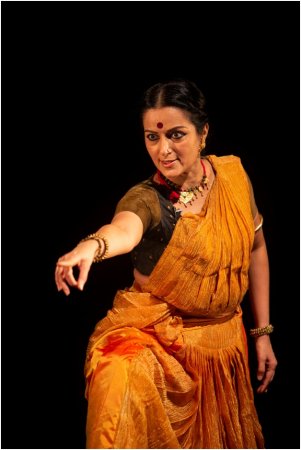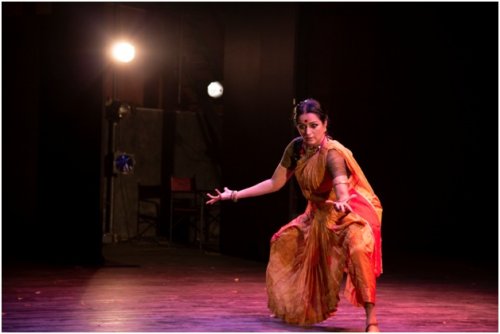
|   |

|   |
Draupadi in Still I Rise is a woman dishonoured across time - Dr. S.D. Desai e-mail: sureshmrudula@gmail.com December 6, 2019 For a couple of reasons, Bharatanatyam dancer from Chennai/USA, Vidhya Subramanian's portrayal of Draupadi in Still I Rise lingers in memory. The foremost among them is a delicate and subtly suggestive way in which she has used the classical dance vocabulary and her power of controlled abhinaya for it. A second is her interpretation of the character which she has spring from the mythological frame and stand in front of us talking unassumingly in first person in a language comprehensible to us today. In the process we feel she herself steps aside from her character and with conviction talks to us.  She keys her nuanced stage portrayal in not full light most of the time to words in poetic lines in Hindi, Bengali, Tamil, Kannada and English expressing her varying moods and sentiments enhanced with music (Rajkumar Bharati). The title is drawn from African American poet Maya Angelou's significant poem, wherein she says: "Out of the huts of history's shame I rise / Up from a past that's rooted in pain I rise." Draupadi is seen in the opening scene rising as from a pile of ashes deep in the centre of the stage recalling in agony the loss of her children in the Mahabharata War. Vidhya, who has conceptualized and choreographed the piece and also scripted it with Priya Das, does not attempt a linear narrative. Rather, she forms an artistically telling collage of episodes central to her theme. The desire for revenge chased her in most circumstances of life. Revenge was the cause of her birth. She caused Karna the desire for revenge at her swayamvara. Her humiliation in Kauravas' court in the presence of elders and husbands had Bhima pledge a bloody revenge. Revenge dominated the battles in the Kurukshetra war. She recalls annihilation of all of Gandhari's sons, a parallel rarely drawn in giving voice to the character and underlines her silence in the court. Kannada poet Kumara Vyasa's verbal description of Bhima's action - 'her hair kneaded with blood', 'combed with his row of teeth, then braided and decorated with his intestines', 'her forehead anointed with his blood' - reminds us of a Kathakali depiction of violence. The performer remains coolly expressive with her anguish. Her controlled introspective reaction if she needed a man to avenge her gives altogether a different perspective to Draupadi's character she has developed as Kundalini, the highest divine form of femininity that liberates. Draupadi is also depicted as the sixth sense unlike the five represented by Pandavas.  The composite flowing visual image that begins with the suggestion of Draupadi's vastraharana climaxing in Krishna helping her with an endless length of fabric to cover her body and slips into an even stronger suggestion of a woman struggling with her feet lying supine as her sari coils into knots against an invisible omnipresent violator of her honour is a richly connotative original piece of artistry. That's where you feel prompted to know the name of the costume designer (Sandhya Raman) and the light designer. The transition now is across time. Vidhya Subramanian turns Draupadi into a symbol of a woman disgraced. She sees Draupadi in every woman whose dignity keeps getting violated by a brazen male gaze and the most abominable male action. The writer-choreographer-performer's solo performance Still I Rise ends with a ringing clarion call to women in the contemporary world with Pushyamitra Upadhyay's now famous lines: Suno Draupadi, shastra uthaa lo, ab Gobinda na aayenge - Listen Draupadi, fight for your honour, Govinda will not now come to protect you. Dr. S.D. Desai, a professor of English, has been a Performing Arts Critic for many years. Among the dance journals he has contributed to are Narthaki, Sruti, Nartanam and Attendance. His books have been published by Gujarat Sahitya Academy, Oxford University Press and Rupa. After 30 years with a national English daily, he is now a freelance art writer. |